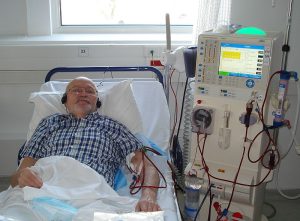The Business of Medicine
 Introduction
Introduction
Healthcare is a business that drives innovation and growth. While most consider healthcare strictly in terms of physicians, nurses, and patients, the business of healthcare needs careful management to continue achieving its health-related mission. The healthcare industry is different from others in some very fundamental ways. The business side monitors the bottom line, which directly affects the quality of patient care and the cost of services. Therefore, the bottom line needs to be positive to invest in equipment, technology, and competitive staff compensation. Another definitive difference between healthcare and other industries is that large segments of healthcare are dominated by nonprofit providers, and payments are made by third parties, including private insurers and the government.
Learning Objectives
-
Describe the distinctive elements of health as a business enterprise
-
Identify professional norms in healthcare
-
Summarize the rise of for-profit medicine through the lens of specialty hospitals and hospice providers
Healthcare Priorities
Whether an organization is a for-profit or a non-profit entity, it cannot stay in business if it is unable to generate income to keep the lights on and make payroll. Organizations must balance financial solvency with the well-being of patients. In healthcare, patients are the primary stakeholders. However, one critical difference is the asymmetry of information, where a patient may never have a complete understanding of their medical condition or the costs associated with treatment. Trust between the patient and provider is critical. The complex patient-physician relationship creates a unique transaction experience with few comparables.
A. For-Profit Hospitals
There are approximately 1,000 proprietary hospitals in the US that provide short-term care. Almost half are owned by large corporations that specialize in hospital management, while the other half are owned by groups of private investors. Proprietary hospitals are for-profit and characterized by having 250 beds or less and offering inpatient and outpatient services. Most are located in small or medium towns, and virtually none are found in states with strong commissions or certificate-of-need policies. Proprietary hospitals are considered to have more efficient management and use fewer employees per bed. Patients in proprietary hospitals are typically not lower-income or covered through Medicaid. Proprietary hospitals generally have per diem rates comparable to voluntary hospitals; however, ancillary charges are higher.
The COVID-19 pandemic, as well as cost escalations related to the nationwide shortage of nurses, resulted in inflating labor costs. HCA Healthcare, one of the biggest operators of for-profit healthcare facilities, manages an 182-hospital system based in Nashville, TN. HCA reported $6.94 billion in expenses tied to salaries and benefits in the first quarter of 2022, a 10.1 percent year-over-year increase (Ellison, 2022).
B. Proprietary Nursing Homes

Nursing home residents account for one percent of the US population (Warraich, 2021). Several legislative changes were created during the COVID-19 pandemic to support the 36 percent increase in federal expenditures for healthcare expenses associated with the COVID response (Hartman et al., 2021). Due to the lack of personal protective equipment (PPE) and nursing-patient ratios, six studies showed that the risk of infection and death from COVID-19 was significantly higher in for-profit nursing homes (Warraich, 2021). Contrarily, these studies also found that the quality of care improved when ownership changed to not-for-profit. Further encouraging health disparities, these proprietary homes are more likely to care for Black and Hispanic patients. While many states began to lobby for legislation that protected nursing homes from lawsuits during the pandemic, the delivery of care began to suffer as for-profit nursing homes received millions in government funding (Warraich, 2021). Some unscrupulous practices ensued, with investors buying nursing homes and then renting these spaces back to operators with excessive management fees.
C. Home Health & Hospice Care
A variety of home services are provided by for-profit entities. Services include nursing care, homemaking assistance, respiratory therapy, occupational and physiotherapy, and hospice care. These services generate a multi-billion-dollar profit. Approximately half the total cost of home health care is covered by Medicare. As Medicare and private third-party coverage expand, the rapidly growing expenditures for care continue to increase.
Two-thirds of hospice providers in the US are for-profit. Correspondingly, the cost of hospice care has increased while the quality of care has decreased. The need for elderly care, like patients with dementia, has increased convergence between for-profit nursing homes and hospices. Over 20 percent of nursing homes and hospice providers have common ownership (Department of Health and Human Services, 2018). This relationship has increased the cost of care. While many have been charged with fraud, many lobbyists are recommending the elimination of immunity provisions (Warraich, 2021).
The Centers for Medicare & Medicaid Services (CMS, 2022a) issued updates to the Medicare payment policies and rates for skilled nursing facilities under the Skilled Nursing Facility Prospective Payment System (SNF PPS) for fiscal year 2023, which aims to ensure the safety of both nursing home residents and staff and improve the quality of services. By 2025, $265 billion worth of care services for Medicare could shift to the home (Bestsennyy et al., 2022).
D. Laboratory & Emergency Services

The global laboratory services market is expected to grow 4.21% over the forecast period, from $365.690 billion in 2019 to $468.249 billion by 2025 (CMS, 2022b). Almost a third of these laboratories are owned by for-profit companies. Some operate laboratories in not-for-profit hospitals as well. Other ancillary services sold by these companies include cardiopulmonary testing, CAT scans, industrial health screening, weight-control clinics, dental care, alcohol and drug programs, rehabilitation counseling, and prepaid HMO programs. Two additional markets are emergency room services and long-term hemodialysis for end-stage renal disease.
The Emergency Medical Treatment & Labor Act (EMTALA) passed by Congress in 1986, ensures public access to emergency services regardless of ability to pay. As part of this legislation, Medicare-participating hospitals must offer medical screening examinations for emergent medical conditions such as active labor (CMS, 2022b). Combined with the decline in general practice providers making house calls, the dependency on emergency room visits has skyrocketed over the past few decades. Additionally, third-party payers reimburse at higher rates for emergency care than the same care provided in a doctor’s office. These actions coalesce in an industry that specializes in emergency services. Services can include the facility, emergency care packages, and professional staffing. Locum tenens, temporary physicians work in varying locations, allowing physicians and training residents to provide medical services often without board certification. The average hospitalist working 15 shifts a month makes around $280K/year. Working 15 shifts/month as a locum tenens hospitalist makes a minimum of $350K annually (todayshospitlaist.com, 2023). While locum tenens can relieve burnout or fill a temporary void left by departing physicians, the costs are significantly higher. Several studies have shown that there is limited empirical evidence to support the assumptions about the quality and safety of locum practice (Ferguson & Walshe, 2019). In other words, there appears to be no greater risk of harm to patients when staffing is provided by locum tenens. This is specifically important in rural areas with physician staffing issues.
E. Hemodialysis

The Social Security Act of 1972 was amended to expand Medicare funding for end-stage renal disease. The number of patients requiring dialysis has grown exponentially over the decades. According to the National Institute of Diabetes and Digestive and Kidney Disease, nearly 786,000 Americans have end-stage renal disease, 71% are on dialysis, and 29% will receive a kidney transplant (2023). As of August 2022, 89,931 people were on the waiting list for a kidney transplant, while only 20,663 transplants had been performed, according to the U.S. Organ Procurement and Transplantation Network. Medicare spending per person for those with chronic kidney disease was more than double the amount for those without, according to the USRDS 2020 annual report.
The number of proprietary dialysis facilities has continued to trend upward in parallel with the needs of patients. Free-standing facilities typically have lower expenses in comparison to dialysis units located in hospitals. Some proprietary companies have expanded their services to include the sale of dialysis equipment and supplies. The national dialysis market is controlled by two for-profit organizations, one is DaVita, which controls 37% of the market (Childers et al., 2019). US kidney dialysis clinics form a profitable $24 billion industry, with four large proprietary firms capturing more than 85% of the revenues (LaRosa, 2019).
F. Technology
The new healthcare industry is expanding rapidly and is highly profitable. The expansive nature of healthcare and the displacement of patients during Hurricane Katrina sparked a governmental push to increase the role of technology in healthcare with the use of electronic medical records (EMR), also called electronic health records (EHR). Two of the most used companies in the US, Epic and Cerner, are cloud-based software development companies with a large market share across the healthcare industry. Epic covered almost 31%, and Cerner held around 25% of the total EHR market share in 2020. Epic’s revenue hit $3.8 billion in 2021 (Dyrda, 2022) while Cerner’s 2021 revenues pulled in $5.765 billion, up 5% from 2020 (Jercich, 2022). Costs for technologies range from $15K-$70K per provider. Electronic health records not only improve efficiency but also increase the portability of medical records and decrease medical errors, thereby improving patient safety. Costs to consider include the purchase of the software package subscription, implementation/development, ongoing upgrades, and optimization. In addition to those costs are expenses for IT personnel and provider training. Many of these expenses were offset by Medicare and Medicaid EHR Incentive Programs to promote interoperability between EHR systems. Between 2011 and 2017, financial incentives were provided to healthcare organizations through “Meaningful Use.” As US healthcare payments shifted from a “fee-for-service” model to focus on quality outcomes, many payment models require EHRs that are meaningful use compliant, further pushing the requirements placed on technology that follows governmental guidelines for interoperability.
Healthcare as a Private Business
Considering the aforementioned revenues generated from healthcare combined with the growing complexity and need for healthcare services, the healthcare industry is inevitably attractive to businesses (Perry & Thompson 2017). Healthcare’s growing need for technology is a massive investment of capital, which presents a problem for nonprofit institutions. Private entrepreneurs come with the capital needed to build and equip new hospitals, nursing homes, and laboratories and to start new healthcare businesses. With profits ensured, consumers expect improved efficiency and quality of healthcare. Two major differences in healthcare that make it a unique market are the goods and consumers. Because most people consider it a basic right, healthcare differs from other businesses. Public funds pay for most of the research needed to develop new medications and new medical technology. Additionally, more US citizens are receiving tax-supported medical care through Medicare and Medicaid and other types of public programs. A second unique feature of the healthcare market is that most consumers (i.e., patients) are not “consumers” at all. Patients who are seriously ill do not have the ability to “shop around” for the best price; therefore, the laws of supply and demand do not apply the same to healthcare. Assumptions about a competitive free market do not apply to healthcare, considering the dependence of patients on the judgment of the providers. Typically, the healthcare expenditures are based on the decisions of providers. Patients with lower health literacy were associated with increased reports of poor physical functioning, pain, limitations in daily activities, and poor mental health status. All these special characteristics of the healthcare market conspire to produce an atypical situation when a private business enters the equation. A private corporation in the healthcare business uses technology often developed at public expense, and it sells services that most Americans regard as their basic right but are heavily subsidized by public funds, largely allocated through the decisions of physicians rather than consumers, and almost entirely paid for through third-party insurance (Perry & Thompson 2017). The possibilities for abuse are obvious.
A. The Uninsured
Currently, 1 in 10 (approximately 8.0%) of Americans are uninsured, according to the U.S. Census Bureau Household Pulse Survey data from March 2022. While this percentage has fallen from 10.5% since 2020, rates tend to be higher in the Southern regions: Mississippi (14.4%), Texas (13.0%), Oklahoma (12.4%), and Georgia (12.0%). Other large disparities exist, with 13% of uninsured reported being between the ages of 18 and 24, and the second largest uninsured demographic being 11.8% between the ages of 25 and 39. Education was a large predictor of health insurance status, with 20.9% of insureds reporting not having a high school diploma. In contrast, only 3.3% with a bachelor’s degree or higher reported being uninsured (Festa, 2022). 17.0% of the uninsured reported being Hispanic/Latino while 9.5% were Black Americans. This stands in contrast to 6.0% of Asian Americans and 5.4% of white Americans who reported being uninsured. Two other large predictors of insurance status are household size and income. Families with children under 18 (10.2% vs. 6.7% without children) and whose income was less than $25K annually reported being uninsured more than individuals with higher income (7.0% under $60K annually, 2.4% at $100K annually) (Festa, 2022). Most Americans obtain insurance through their employers, which further complicated coverage during the COVID-19 pandemic when many Americans (specifically Latinos) lost coverage. The unregulated market approach in healthcare fails to resolve social inequalities and injustices that arise when the market fails to provide access to uninsured or underinsured patients.
B. Role of the Medical Professional
Because healthcare is a unique market for the aforementioned reasons, the answer to overuse may fall on the medical provider acting on behalf of the patients. Providers can help patients navigate cost-effective options for treatment, pharmaceutical discounts, and determine the necessity of each option. The provider should shop for goods and services that are the most cost-effective for the patients. Physicians should have no economic conflict of interest when providing care; however, physicians with proprietary hospitals and nursing homes, diagnostic laboratories, dialysis units, and many small companies represent the stockholders of these corporations.

Currently, there are no principles adopted by the American Medical Association’s (AMA) Principles of Ethics regarding the declaration of physicians’ financial interests. A statement about practicing physicians deriving no financial benefit from the healthcare market except their own professional services should become part of the ethical code of the AMA. It would have no legal force but would be accepted as a standard for the behavior of practicing physicians throughout the country (Perry & Thompson, 2017). In the Opinions and Reports of the Judicial Council, it states that “It is not in itself unethical for a physician to own a for-profit hospital or interest therein,” confirming that there is nothing inherently improper in physicians’ owning or investing in healthcare businesses. However, acting in their own financial interests by overusing services or obtaining kickbacks and rebates would be considered improper. This stance only addresses abuse and ignores physicians’ responsibilities to evaluate drugs, devices, diagnostic tests, and therapeutic procedures in the public interest. (Opinions and Reports, Section 4.40(2)). “If the AMA took a strong stand against any financial interest of physicians in healthcare businesses, it might risk an antitrust suit,” according to Perry & Thompson (2017). This is specifically concerning when the physician is acting as the purchasing agent for the patient while the public pays the majority of the bill.
Another critical problem emerging from the increasing commercialization of healthcare is the so-called “cream-skimming” phenomenon. Proprietary hospitals can concentrate on providing the most profitable services to the best-paying patients, thereby skimming the cream off the market. According to Perry & Thompson (2017), this can be achieved in two ways: the elimination of low-frequency and unprofitable services and the exclusion of unprofitable patients (e.g., uninsured patients or those with complex and chronic illnesses). The not-for-profit healthcare facility could not employ such practices. Another form of skimming in the proprietary hospitals’ is the lack of residency and other training programs. To provide an adequate and up-to-date range of experiences that are often expensive, large teaching hospitals are obliged to maintain services that are not necessarily economically viable.
Type of Healthcare Organization
Healthcare organizations are responsible for providing patients with a wide range of services, including preventive care, diagnosis, treatment, and rehabilitation. The specific services that they offer and the populations that they serve can vary widely.
- Hospitals: Hospitals are the most complex and comprehensive type of healthcare organization. They provide a wide range of services, including inpatient care, outpatient care, and emergency care.
- Clinics and medical offices: Clinics and medical offices are typically smaller than hospitals and offer a more limited range of services. They may specialize in a particular area of medicine, such as primary care, pediatrics, or surgery.
- Nursing homes: Nursing homes provide care for people who need assistance with daily living activities. They may offer short-term or long-term care.
- Mental health and addiction treatment centers: Mental health and addiction treatment centers provide care for people with mental health disorders or substance abuse problems.
- Home health agencies: Home health agencies provide care to people who are unable to leave their homes for medical reasons. They may provide nursing care, physical therapy, or other services.
- Public health organizations: Public health organizations work to improve the health of the population as a whole. They may focus on prevention, education, or research.
- Health insurance companies: Health insurance companies provide financial protection for people who need medical care. They may reimburse patients for services or pay hospitals and other healthcare providers directly.
A. For-Profit vs. Not-for-Profit
For-profit healthcare organizations are owned by investors and shareholders (either public or private), whereas not-for-profit organizations are managed by either a state or local government entity. What does this mean exactly? Any profits obtained by a for-profit entity can be distributed among investors, who then pay income and property taxes. Not-for-profits are legally obligated to invest any profits generated back into the organization to benefit the community.
Many patient advocates, labor unions, and bioethicists believe that with this configuration, for-profit healthcare providers’ interests lie with shareholders and investors rather than the patient. Some go further to accuse for-profit providers of denying care to patients who are not insured or have Medicaid (Perry & Thompson, 2017).
B. Physician-Owned Specialty Hospitals
Physician-owned hospital means any hospital in which a physician, or the immediate family member of a physician, has an ownership or investment interest. These entities are either partially or fully owned by physician-investors. They also limit the number of services offered to only a few that provide high-profit margins, like cardiology, orthopedics, or outpatient surgical procedures. These specialty hospitals cherry-pick patients who are typically not severely ill. By limiting access to healthier patients, costs are reduced in relation to technology and personnel needed for treatment. Additionally, the costs at these facilities are higher (Perry & Thompson, 2017).
It is important to note that healthcare legislation drives trends in all areas of healthcare. Decades ago, drastic reductions in Medicare reimbursements forced a mass exodus to physician-owned specialty hospitals. Further exacerbating these disgruntled departures was the dissatisfaction of physicians with administrators and government bureaucrats. Decreasing physicians’ salaries fueled by profit motivation, physician-owned specialty hospitals were propelled by the physicians’ frustrations concerning efforts to exercise control of their clinical practices. In doing so, many physicians actively pursued the more lucrative patient population for higher profits; notably, there were fewer, if any, Medicaid patients. This action ultimately resulted in damage to the healthcare industry for both the system and the patients. Some private health systems responded by destabilizing the threat of administrators for physicians who remained affiliated with the hospitals. Physicians referred their least costly and most healthy patients to facilities in which they had an ownership interest while sending the more complex cases to general hospitals. However, many of these physician-owned specialty hospitals were not in compliance with the Centers for Medicare & Medicaid Services (CMS) Conditions of Participation, including having an on-site emergency department and patient safety standards. In March 2010, Congress passed the largest legislative healthcare reform with the Affordable Care Act (or Obamacare). A portion of this legislation was dedicated to curbing the expansion of physician-owned specialty hospitals (Perry & Thompson, 2017).
C. For-Profit Hospice
 The earliest considerations of hospice care arose in the 1960s but didn’t emerge as the concept as we know it until the 1980s. The growth of hospice care spread rapidly in the 1970s, with mostly small volunteer-dominated, community-based programs that provided spiritual support and palliative care. By the late 1970s, there were approximately 60 hospice providers in America. That number exploded in the early 1980s to over 400. Policymakers began to take notice, and Congress created Medicare hospice benefits in 1982 for patients deemed terminally ill with less than 6 months to live. These federal benefits pay a fixed per diem rate, which includes routine home care, continuous home care, inpatient respite care, or general inpatient care. The per diem rate covers services that include nursing care, physician services, pain management, medical social services, counseling (including bereavement services), physical therapy, occupational therapy, speech-language pathology, dietary counseling services, and homemaking services, whether they are provided or not. Throughout the 1990s, the per diem rates paid by Medicare steadily increased, and by 2006, 40% of Medicare beneficiaries had received hospice care prior to death. Between the years 1992 and 2002, Medicare payments for hospice care increased fivefold, as did the number of Medicare-participating hospice providers. Within the next 6 years, hospice expenditures exceeded $11 billion. Concurrently, the for-profit hospice industry grew by 128%, while the nonprofit sector only grew by 1% (Perry & Thompson, 2017). Based on this information, it is reasonable to predict that the rising availability and awareness of hospice care could lead to more Medicare beneficiaries choosing it for end-of-life care.
The earliest considerations of hospice care arose in the 1960s but didn’t emerge as the concept as we know it until the 1980s. The growth of hospice care spread rapidly in the 1970s, with mostly small volunteer-dominated, community-based programs that provided spiritual support and palliative care. By the late 1970s, there were approximately 60 hospice providers in America. That number exploded in the early 1980s to over 400. Policymakers began to take notice, and Congress created Medicare hospice benefits in 1982 for patients deemed terminally ill with less than 6 months to live. These federal benefits pay a fixed per diem rate, which includes routine home care, continuous home care, inpatient respite care, or general inpatient care. The per diem rate covers services that include nursing care, physician services, pain management, medical social services, counseling (including bereavement services), physical therapy, occupational therapy, speech-language pathology, dietary counseling services, and homemaking services, whether they are provided or not. Throughout the 1990s, the per diem rates paid by Medicare steadily increased, and by 2006, 40% of Medicare beneficiaries had received hospice care prior to death. Between the years 1992 and 2002, Medicare payments for hospice care increased fivefold, as did the number of Medicare-participating hospice providers. Within the next 6 years, hospice expenditures exceeded $11 billion. Concurrently, the for-profit hospice industry grew by 128%, while the nonprofit sector only grew by 1% (Perry & Thompson, 2017). Based on this information, it is reasonable to predict that the rising availability and awareness of hospice care could lead to more Medicare beneficiaries choosing it for end-of-life care.
Marketing For-profit Hospice Services

Some of the largest hospice providers successfully grow their business by sending patient recruiters into nursing homes to market hospice services and recruit patients. As expected, many of these practices have become unethical and warrant investigation. In 2009, the Medicare Payment Advisory Commission exposed this conflict of interest between the financial relationships of hospice providers and long-term care facilities. Given the heightened emotions and vulnerability of these dying patients and their caregivers, potential informed decision-making is susceptible to unscrupulous marketing that overpromises the services that will be provided. Medicare found hospice providers maximize the length of stay for profits. The initial costs of transitioning patients to hospice care are higher in the first four days as well as the last four days prior to death. Although costs in between those times are lower, the longer the duration of the patient’s stay, the higher the overall profits. Studies found that for-profit hospices selectively admitted patients with primary diagnoses and younger ages than religious or non-profit hospices, which corresponds with higher profits (Perry & Thompson, 2017).
Compromised Quality of Care by Hospice Providers
Holistic end-of-life care with a coordinated interdisciplinary care team is the hallmark of hospice. Federal law mandates care pursuant to an individual patient’s written plan, including access to physician services, skilled nursing care, dietary or nutritional services, psychological counseling, spiritual care, and medical social services (Perry & Thompson, 2017). Other services include occupational therapy, speech therapy, physical therapy, continuous home care, and homemaker services. Basic hospice services include:
- Providing patient care, including pain management
- Coordinating care with the family or nursing home
- Ordering medications
- Grief counseling
- Support for caregivers
- Education to family members on caregiving
- Religious or community resources
- Burial arrangements assistance
For-profit hospice providers were noted to use less-skilled nursing staff. For-profit hospice patients received significantly fewer services than non-profit hospice patients. Hence the name for-profit, the financial bottom line is driving the creation of profits for its investors. Although quality is difficult to measure in hospice care, new quality self-reporting metrics show that for-profit hospice providers are scoring lower than not-for-profit.
Key Takeaways
-
Distinctive elements of health as a business enterprise include monitoring the bottom line, which directly affects the quality of patient care and the cost of services. The bottom line needs to be positive to invest in equipment, technology, and competitive staff compensation. Large segments of healthcare are dominated by nonprofit providers, and payments are made by third parties, including private insurers and the government.
-
Professional norms in healthcare include the medical provider acting on behalf of the patients. Providers can help patients navigate cost-effective options for treatment, pharmaceutical discounts, and determine the necessity of each option. The provider should shop for goods and services that are the most cost-effective for the patients. Physicians should have no economic conflict of interest when providing care; however, physicians with proprietary hospitals and nursing homes, diagnostic laboratories, dialysis units, and many small companies represent the stockholders of these corporations.
-
Physician-owned hospitals are hospitals in which a physician, or an immediate family member, has an ownership or investment interest and are either partially or fully owned by physician investors. By limiting access to healthier patients, costs are reduced. For-profit hospice patients receive significantly fewer services and have lower-skilled caregivers. However, little evidence is provided to support a difference in quality between for-profit versus not-for-profit hospice providers.
References
- Bestsennyy, O., Chmielewski, M., Koffel, A., & Shah, A. (2022). From facility to home: How healthcare could shift by 2025. McKinsey & Company. https://www.mckinsey.com/industries/healthcare/our-insights/from-facility-to-home-how-healthcare-could-shift-by-2025
- Centers for Medicare & Medicaid Services (2022a). CMS Acts to Improve the Safety and Quality of Care of the Nation’s Nursing Homes https://www.cms.gov/newsroom/press-releases/cms-acts-improve-safety-and-quality-care-nations-nursing-homes
- Centers for Medicare & Medicaid Services (2022b). Emergency Medical Treatment & Labor Act (EMTALA). https://www.cms.gov/medicare/regulations-guidance/legislation/emergency-medical-treatment-labor-act#:~:text=In%201986%2C%20Congress%20enacted%20the,regardless%20of%20ability%20to%20pay.
- Childers CP, Dworsky JQ, Kominski G, Maggard-Gibbons M. A Comparison of Payments to a For-profit Dialysis Firm From Government and Commercial Insurers. JAMA Intern Med. 2019;179(8):1136–1138. doi:10.1001/jamainternmed.2019.0431
- Dyrda, L. (2022, July 13) Epic’s revenue up 13% in 2021, Hit $3.8B. Becker’s Health IT. https://www.beckershospitalreview.com/ehrs/epic-s-revenue-up-13-in-2021-hit-3-8b.html
- Ellison, A. (2022, April 22). HCA’s profit dips to $1.2B as labor costs rise. Becker’s Hospital CFP Report. https://www.beckershospitalreview.com/finance/hca-s-profit-dips-to-1-2b-as-labor-costs-rise.html
- Ferguson, J. and Walshe, K. (2019). The quality and safety of locum doctors: A narrative review. Journal of the Royal Society of Medicine, 112(11): 462–471. doi: 10.1177/0141076819877539
- Festa, L. (2022, Apr, 25). 8% of Americans are uninsured, but looming expiration of public health emergency threatens to increase that rate. ValuePenguin. https://www.valuepenguin.com/uninsured-rates-study#:~:text=About%201%20in%2010%20%E2%80%94%208.0,April%20and%20early%20May%202020.
- Hartman, M., Martin, A. B., Washington, B., Catlin, A., and The National Health Expenditure Accounts Team. (2021, Dec. 15). National Health Care Spending in 2020: Growth Drive by Federal Spending in Response to the COVID-19 Pandemic, 41(1). https://doi.org/10.1377/hlthaff.2021.01763
- Jercich, K. (2022, Feb. 23). Cerner revenue up, net earnings down in 2021. Healthcare IT News. https://www.healthcareitnews.com/news/cerner-revenue-net-earnings-down-2021
- LaRosa, J. (2019, July 29). US Kidney Dialysis Clinics Form a Profitable $24Billion Industry. Market Research Blog
- Morgan, J. F. (2019). Business Law. 6th ed. BVT Publishing, LLC
- National Institute of Diabetes and Digestive and Kidney Disease (2023). Kidney Disease Statistics for the United States: Fast Facts on Kidney Disease https://www.niddk.nih.gov/health-information/health-statistics/kidney-disease
- Organ Procurement & Transplantation Network (2023). Data https://optn.transplant.hrsa.gov/data/
- Perry, J. E. & Thompson, D. B. (2017). Law and Ethics in the Business of Health Care. West Academica Publishing
- Stevenson, D., Sinclair, N., Zhang, S., Meneades, L., & Huskamp, H. (2018, Nov. 30) Trends in nursing home-Hospice contracting and common ownership between hospice agencies and nursing homes: Final report. ASPE Office of the Assistant. Secretary for Planning and Evaluation.https://aspe.hhs.gov/reports/trends-nursing-home-hospice-contracting-common-ownership-between-hospice-agencies-nursing-homes
- Warraich, H. J. (2021, April 19). For-profit nursing homes and hospices are a bad deal for older Americans. STAT. https://www.statnews.com/2021/04/19/for-profit-nursing-homes-hospices-bad-deal-older-americans/
- Wood, L. (2020, Dec. 18). Global $438.24 Billion laboratory services market to 2025. Globe Newswire. https://www.globenewswire.com/en/news-release/2020/12/18/2147823/28124/en/Global-468-24-Billion-Laboratory-Services-Market-to-2025.html
- Today’s Hospitalist (2023). Compensation & Career Survey Results. 2023 Survey Results. https://www.todayshospitalist.com/salary-survey-results/
- U.S. Department of Health and Human Services (2018). Trends in Nursing Home-Hospice Contracting and Common Ownership between Hospice Agencies and Nursing Homes: Final Report. https://aspe.hhs.gov/reports/trends-nursing-home-hospice-contracting-common-ownership-between-hospice-agencies-nursing-homes
A term used to define minimum U.S. government standards for electronic health records (EHR), outlining how clinical patient data should be exchanged between healthcare providers, between providers and insurers and between providers and patients.
The degree to which individuals have the capacity to obtain, process, and understand basic health information needed to make appropriate health decisions. Low health literacy is more prevalent among: Older adults.
refers to choosing patients for some characteristic(s) other than their need for care, which enhances the profitability or reputation of the provider.

